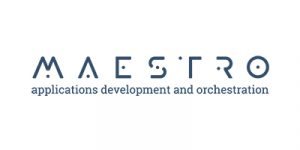 UBITECH has successfully demonstrated the MAESTRO end-to-end orchestration framework for Cloud-native applications over 5G infrastructure in the MATILDA review meeting that took place in Genoa during 22-23 November 2018. The realised demonstration regarded the deployment and orchestration of a “5G emergency communications” application, provided by ININ (Ljubljana, Slovenia), supporting communication and interaction among first responders over an application aware network-slice. In more detail, the provided application was on boarded to the MAESTRO development environment, where the set of networking requirements to be considered during placement were specified. Such requirements led to the creation of a slice intent (description of the network slice to be supported for this application). The latter led to a request from the Cloud orchestration mechanisms to the underlying, fully incorporated OSS for the automated creation of the appropriate network slice, as well as the activation of the required network services in the NFVO (OSM). It should be noted that the request is based on the specification and implementation of open APIs for the interaction among the Cloud orchestration mechanisms and the OSS, following the evolving 3GPP specifications (e.g. based on the results of the 3GPP Common API Framework Study). Upon the creation of the network slice instance, Cloud and network orchestration mechanisms were activated, leading to the efficient provision of the application. The deployment was realised over the 5G end-to-end facility provided by CNIT (Genoa, Italy), covering the radio access, transport and core network part. Following the application’s provision, scenarios related to the scaling of the application components given the workload characteristics were realised. The overall demonstration showed the main operational aspects of the MAESTRO orchestration framework, focusing on the capacity for realising end-to-end orchestration of Cloud-native applications over 5G infrastructure.
UBITECH has successfully demonstrated the MAESTRO end-to-end orchestration framework for Cloud-native applications over 5G infrastructure in the MATILDA review meeting that took place in Genoa during 22-23 November 2018. The realised demonstration regarded the deployment and orchestration of a “5G emergency communications” application, provided by ININ (Ljubljana, Slovenia), supporting communication and interaction among first responders over an application aware network-slice. In more detail, the provided application was on boarded to the MAESTRO development environment, where the set of networking requirements to be considered during placement were specified. Such requirements led to the creation of a slice intent (description of the network slice to be supported for this application). The latter led to a request from the Cloud orchestration mechanisms to the underlying, fully incorporated OSS for the automated creation of the appropriate network slice, as well as the activation of the required network services in the NFVO (OSM). It should be noted that the request is based on the specification and implementation of open APIs for the interaction among the Cloud orchestration mechanisms and the OSS, following the evolving 3GPP specifications (e.g. based on the results of the 3GPP Common API Framework Study). Upon the creation of the network slice instance, Cloud and network orchestration mechanisms were activated, leading to the efficient provision of the application. The deployment was realised over the 5G end-to-end facility provided by CNIT (Genoa, Italy), covering the radio access, transport and core network part. Following the application’s provision, scenarios related to the scaling of the application components given the workload characteristics were realised. The overall demonstration showed the main operational aspects of the MAESTRO orchestration framework, focusing on the capacity for realising end-to-end orchestration of Cloud-native applications over 5G infrastructure.


